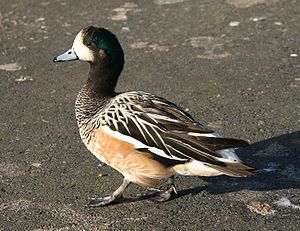Chile Wigeon
| Chile Wigeon | ||||||||||||
|---|---|---|---|---|---|---|---|---|---|---|---|---|

Chilean wigeon ( Anas sibilatrix ) |
||||||||||||
| Systematics | ||||||||||||
|
||||||||||||
| Scientific name | ||||||||||||
| Mareca sibilatrix | ||||||||||||
| Poeppig , 1829 |
The Chilean wigeon ( Mareca sibilatrix ), also known as the Chilean wigeon , is a monotypical species from the duck family . It is native to southern South America and the Falkland Islands. Although it is heavily hunted in Chile, the IUCN classifies the species as not endangered ( least concern ).
Appearance
Chile whistles reach a body length between 43 and 54 centimeters. The wing length is between 23.5 and 27.4 centimeters and its weight is between 828 and 939 grams. Males are usually slightly larger and heavier. The sexual dimorphism is otherwise only very weak.
Chile whistles have a black neck and a black back of the head. The forehead and front face are white. The black sides of the head have a greenish shimmer, although this is more pronounced in males. The flanks of the male are rust-red in color, while those of the female are fluffy brown. The back plumage is streaked with gray with white. The chest is white with a black transverse undulation. Due to the range of variability in plumage coloration, however, no reliable sex determination can be made on the basis of the plumage.
The beak is blue-gray with a black tip. The legs and feet are gray and the eyes are dark brown. Fledglings are similar to adult birds, but the reddish-brown coloration on the flanks is either completely absent or is smaller than that of adult Chili Pigeons.
Distribution and existence
Chile whistles are native to South America. The northern limit of distribution of the breeding area is in Argentina at 36 ° S and in Chile at 40 ° S. In small numbers it also breeds on the Falkland Islands . Odd guests also occasionally reach South Georgia , the South Orkney Islands and the South Shetland Islands .
Chile whistles show a migration behavior depending on their respective habitat. The representatives of this species occurring at the southernmost tip of South America migrate north during the winter half-year and can then be found as far as southern Brazil . The populations found on the Falkland Islands, however, are resident birds.
The IUCN estimates the population at 100,000 to 1,000,000 sexually mature individuals and assumes that the population is stable in the very large distribution area.
Way of life
Chile whistles are native to shallow lagoons , pampa lakes , river plains and small reservoirs . They prefer eutrophic waters. Chile whistles mainly live on vegetable food. They prefer aquatic plants, but also eat grass. Occasionally they are seen feeding on algae-covered rocks on the seashore.
Chile whistles breed between September and December, when spring is already in the southern hemisphere. The pairs only live in very small breeding areas and create their nests in the grass and under bushes. The female lays eight to ten white or light cream colored eggs. The chicks hatch after a breeding period of around 24 to 25 days. The drake takes part in the rearing of the chicks, but then leaves the family group at the moulting season and only joins the group again after the end of the group.
Chile whistles as ornamental poultry
The first Chile whistles were brought from South America to Europe in 1870 and 1871 and were soon bred successfully in zoos. Today, Chile whistles are very widespread ornamental poultry due to their attractive plumage.
supporting documents
literature
- Hartmut Kolbe; Die Entenvögel der Welt , Ulmer Verlag 1999, ISBN 3-8001-7442-1
- Hadoram Shirihai: A Complete Guide to Antarctic Wildlife - The Birds and Marine Mammals of the Antarctic Continent and Southern Ocean , Alula Press, Degerby 2002, ISBN 951-98947-0-5
- Robin and Anne Woods: Atlas of Breeding Birds of the Falkland Islands , Anthony Nelson, Shorpshire 1997, ISBN 0904614-60-3
Web links
- Mareca sibilatrix in the Red List of Threatened Species of the IUCN 2008. Posted by: BirdLife International, 2008. Accessed on December 21 of 2008.
- Videos, photos and sound recordings on Anas sibilatrix in the Internet Bird Collection
Single receipts
- ↑ BirdLife Factsheet on the Chilean Pigeon , accessed on November 26, 2010
- ^ Shirihai, p. 247
- ^ Wood, p. 86
- ↑ BirdLife Factsheet on the Chilean Pigeon , accessed on November 26, 2010
- ^ Shirihai, p. 247


